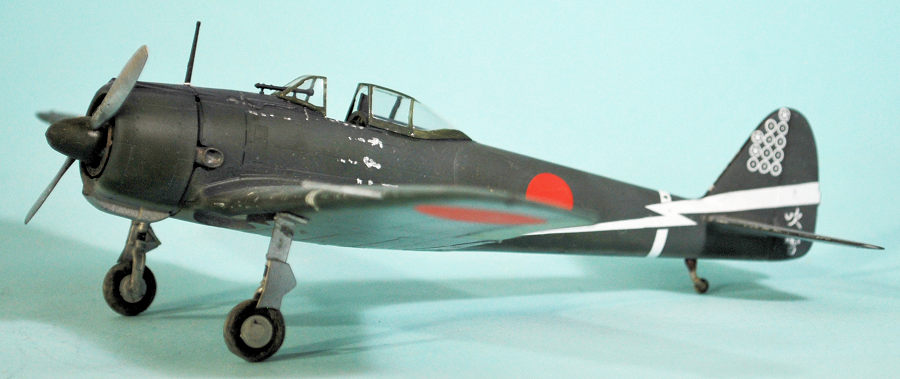
| KIT #: | 07444 |
| PRICE: | $20.95 'used' |
| DECALS: | Two options |
| REVIEWER: | Tom Cleaver |
| NOTES: | Lifelike 48-041 |

| HISTORY |
The Nakajima Ki-43 Hayabusa ("Peregrine falcon") Army Type 1 Fighter was the Imperial Japanese Army Air Force first “modern” fighter with retractable landing gear. In fact, it was a “halfway house” between the ultra-maneuverable Ki-27 and the Ki-44, the first JAAF airplane to emphasize speed and a heavy armament in the “Western style” over maneuverability. During the Pacific War, the Ki-43 was better-known to the Japanese man-in-the-street than the Zero, a situation that changed after the war when Americans who considered any Japanese fighter with a radial engine, low wing and “bubble” canopy to be a “Zero” arrived. Nearly every JAAF fighter pilot flew the airplane at one time or another, and it was responsible for shooting down more Allied aircraft during the war than any other Japanese fighter, Army or Navy.
The Ki-43 was designed by Hideo Itokawa in response to a December 1937 specification issued by the JAAF for a successor to the popular Nakajima Ki-27. The specification called for a top speed of 500 km/h (311 mph), a climb rate of 5,000 m (16,400 ft) in five minutes and a range of 800 km (500 mi). Maneuverability was to be at least as good as that of Ki-27. Initially, the conservative JAAF pilots disliked the fighter, claiming it was not as maneuverable as their beloved Ki-27 (which had also been decried for lack of maneuverability as compared to the Ki-10 biplane when it first showed up).
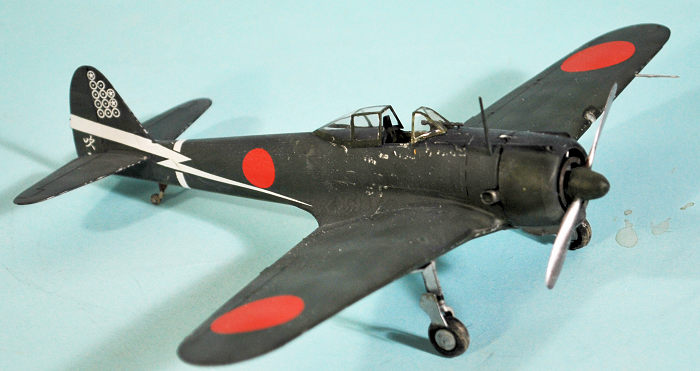 Nakajima produced a series of
progressively modified prototypes through 1939 and 1940. Changes involved a
major weight saving program, a slimmer fuselage with the tail surfaces moved
further aft and a new canopy. Crucially, the 11th prototype introduced the
unique differential "butterfly" maneuvering Fowler flaps, which dramatically
improved performance in tight turns by increasing wing area. The 13th prototype
combined all these changes, and tests resulted in Nakajima being ordered to
place the Ki-43 in production. The fighter gradually found acceptance when such
leading aces as Takeo Kato declared they liked it. Known to Allied pilots by the
reporting name “, the Ki-43 entered frnt-line service just before the outbreak
of the Pacific War, after the first prototype flew in 1939.
Nakajima produced a series of
progressively modified prototypes through 1939 and 1940. Changes involved a
major weight saving program, a slimmer fuselage with the tail surfaces moved
further aft and a new canopy. Crucially, the 11th prototype introduced the
unique differential "butterfly" maneuvering Fowler flaps, which dramatically
improved performance in tight turns by increasing wing area. The 13th prototype
combined all these changes, and tests resulted in Nakajima being ordered to
place the Ki-43 in production. The fighter gradually found acceptance when such
leading aces as Takeo Kato declared they liked it. Known to Allied pilots by the
reporting name “, the Ki-43 entered frnt-line service just before the outbreak
of the Pacific War, after the first prototype flew in 1939.
Among the Allied pilots who mistakenly called the Ki-43 a “Zero” were the pilots of the American Volunteer Group, who held until the last one passed on that they had fought Zeros, not Oscars, despite the nearest Zero never coming within 1,000 miles of Burma or south China during the six months of their existence. Indeed, one could lose a friendship with an AVG pilot if the above facts were pointed out, even if Charles Older might say the forbidden word “Oscar” when describing a fight (as he did in an interview with me in 2002).
Like the Zero, the Ki-43 was of light-weight construction and easy to fly. It became legendary for its combat performance in Southeast Asia in the early years of the war, despite the fact its structure had been lightened to the point it lost strength, leading to the embarrassment of wings coming off in high-G maneuvers and other airplanes grounded when wrinkles in the wing skin around the spar were found. Initially armed with two 7.7mm Type 89 machine guns, armament was upgraded to one 12.7 mm Ho-103 machine gun and one 7.7 mm (.303 in) gun, or two Ha-103s machine guns, firing high explosive bullets. There was a delay in implementing these changes when some of the first so modified shot themselves down when the explosive bullets exploded mere inches in front of the muzzle when fired. Once the structure was beefed up sufficiently to avoid further wing losses, the fighter could safely outmaneuver any opponent, but did so without armor or self-sealing fuel tanks, which meant a well-aimed burst of >50-caliber fire would almost always explode the Hayabusa. Total production amounted to 5,919 aircraft.
The Ki-43 equipped 30 Sentai (flight regiment) and 12 Chutai (independent squadron). The first unit equipped with the Ki 43-I was the 59th Sentai at Hankow in June–August 1941, commencing operational sorties over Hengyang on October 29. The second unit to re-equip was the 64th Sentai led by the JAAF’s leading ace, Colonel Takeo Kato during the fall of 1941
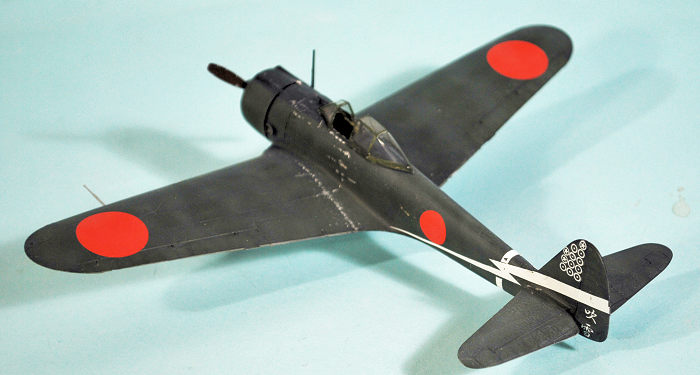 The Ki-43 initially enjoyed air
superiority in the skies of Malaya, Netherlands East Indies, Burma and New
Guinea, having better performance than the Allied types that opposed it and also
flown by experienced pilots. However, as newer Allied aircraft were introduced,
such as the P-47 Thunderbolt, P-38 Lightning, P-51 Mustang, F4U Corsair and F6F
Hellcat, the Oscar came to be seen by Allied pilots as “meat on the table.”
However, as Charles Older pointed out in describing his final combat of the war
in which he shot down four Ki-84s over Hankow and was in turn nearly a victim of
a Ki-43 flown by an experienced JAAF ace, the airplane could still provide a
nasty surprise.
The Ki-43 initially enjoyed air
superiority in the skies of Malaya, Netherlands East Indies, Burma and New
Guinea, having better performance than the Allied types that opposed it and also
flown by experienced pilots. However, as newer Allied aircraft were introduced,
such as the P-47 Thunderbolt, P-38 Lightning, P-51 Mustang, F4U Corsair and F6F
Hellcat, the Oscar came to be seen by Allied pilots as “meat on the table.”
However, as Charles Older pointed out in describing his final combat of the war
in which he shot down four Ki-84s over Hankow and was in turn nearly a victim of
a Ki-43 flown by an experienced JAAF ace, the airplane could still provide a
nasty surprise.
Sergeant Satoshi Anabuki:
The top-scoring Hayabusa pilot was Sergeant Satoshi Anabuki with 39 confirmed victories, 35 scored with the Ki-43.
Born into a farming family in the Kagawa Prefecture,he graduated high school and, after taking the entrance examination for the Juvenile Flying Soldier School, entered the Tokyo Army Aviation School in April 1938, graduating in March 1941 and receiving a promotion to corporal in October. He was assigned to the 3rd Chutai of the 50th Sentai, stationed on Formosa and flying the Ki-27. He fought in the Philippines, claiming his first victory, a P-40E, on December 22, 1941. On February 9, 1942, he shot down two more over Java.
Soon after, the Sentai returned to Japan to re-equip with the Ki-43. The unit was then sent Burma in June 1942. Anabuki was promoted to sergeant in December, 1943. On January 24, 1943, he shot down his B-24 bomber. He later claimed to have shot down three B-24s and one P-38 escort in a fight on October 8, 1943. He reportedly rammed the third B-24, causing so much damage to his airplane that he crash landed, being rescued three days later. In recognition of this achievement he was awarded an individual citation, at the time an unprecedented honor for a pilot who was still alive.
Anabuki was reassigned as an instructor at the Akeno Army Flying School in 1944.In December 1944, he was promoted to sergeant major and returned to action in the Philippines, where he claimed four F6F Hellcats shot down flying the Ki-84 "Hayate". His last victory was a B-29 shot down over Japan in April 1945. When the JASDF was formed in 1955, he rejoined and became a helicopter pilot, retiring after 20 years’ service as a Lt. Colonel. Satoshi Anabuki died in June 2005.
| THE KIT |
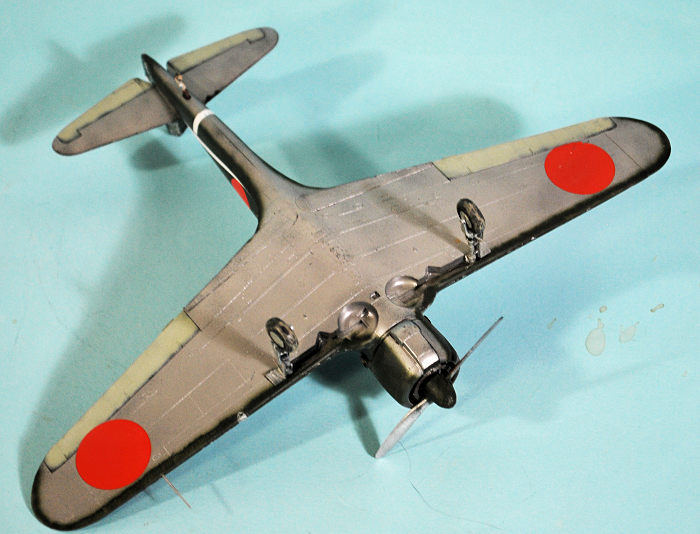 Hasegawa first released the Ki
43-I in 2001, following with a Ki 43-II in 2002. According to Scalemates there
have been 9 re-releases in limited editions featuring different decals.
Hasegawa first released the Ki
43-I in 2001, following with a Ki 43-II in 2002. According to Scalemates there
have been 9 re-releases in limited editions featuring different decals.
The kit is typical Hasegawa, featuring modular construction between the sub-types and a cockpit that is “detailed enough” considering that when assembled the opening is small. The wing tips are separate between the two sub-types, and the “butterfly” flaps are designed to be displayed deployed, though I have seen no photos of Oscars on the ground with these down.
Decals in the kit I have, which is from the first release in 2001, suffer from the markings being in “ivory white”. Fortunately, the excellent Japanese aftermarket decal company Lifelike Decals has several sheets of Ki-43 decals for all the sub-types.
| CONSTRUCTION |
I don’t like Hasegawa’s “thing” about doing their Nakajima fighters with the butterfly combat flaps deployed, since they never were deployed outside of actual flight, and it’s not a simple case of sticking them in their flap wells.
As with the Ki.84, I cut out the flap wells from the lower wing, then fitted the flaps in the openings before proceeding further with the wing assembly. The wingtips need some careful test fitting before committing glue, to get them so they fit smoothly to the wing, The fact that the outer tip goes directly through the ailerons, and any resulting seam needs to be fixed in the fabric detailing, means that the better you can make the fit before gluing, the less trouble afterwards.
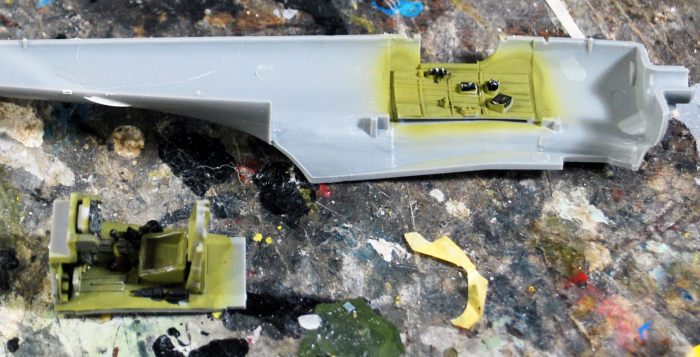 The simple cockpit is assembled
with the inner sidewalls to each fuselage half before assembly, then once the
fuselage is glued together, the floor, with the seat, control stick, rudder
pedals and forward bulkhead including the gun butts and the instrument panel, is
popped in.
The simple cockpit is assembled
with the inner sidewalls to each fuselage half before assembly, then once the
fuselage is glued together, the floor, with the seat, control stick, rudder
pedals and forward bulkhead including the gun butts and the instrument panel, is
popped in.
With careful assembly of the wing to the fuselage, i only had to work on the area to the rear with the lower fuselage, which I putted to fill gaps and sanded smooth. I also filled the “cutout” area behind the cockpit for the canopy to be attached in the closed position, sanding it smooth since I will pose the canopy open. the two rows of cylinders for the engine and the face were painted before I took them off the sprue, assembled and with the exhausts glued to the forward fuselage, with the cowling popped over. The whole process probably took two hours in 20-30 minute breaks from writing over two days.
I filled in the area to the rear of the cockpit that is indented for fit of the cockpit canopy, since that detracts from the look of the model when the canopy is posted open.
| COLORS & MARKINGS |
I first painted the model overall with Tamiya X-18 Semi-gloss Black, thinned 50-50 and misted on. I masked off the area on the fuselage around the cockpit for the antiglare panel.
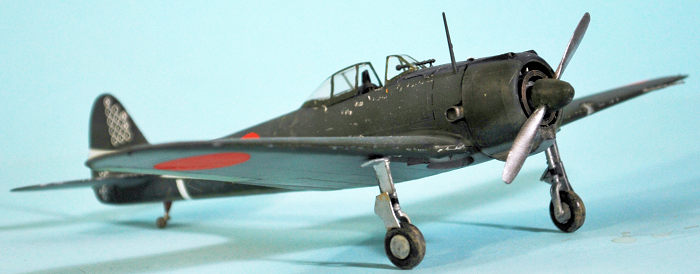 I painted the lower surfaces of
the ailerons and elevators with Tamiya XF-14 “J.A. Grey” then lightened it with
some Tamiya XF-2 Flat White to go over those areas and emphasize detail. I also
used this paint to “blotch” the upper surface. The lower areas were then masked
off, and the lower surfaces were painted with Vallejo “Semi-matte Aluminum,”
misted on to get a flatter finish to simulate the weathering of unpainted
aluminum. I then painted the upper surfaces with Tamiya XF-13 “J.A. Green”,
thinned 50-50 and misted on to get an irregular surface color simulating sun
fading. Since the airplane I am modeling was relatively new, I brought up the
darker color more since sun-fading was not so noticeable yet.
I painted the lower surfaces of
the ailerons and elevators with Tamiya XF-14 “J.A. Grey” then lightened it with
some Tamiya XF-2 Flat White to go over those areas and emphasize detail. I also
used this paint to “blotch” the upper surface. The lower areas were then masked
off, and the lower surfaces were painted with Vallejo “Semi-matte Aluminum,”
misted on to get a flatter finish to simulate the weathering of unpainted
aluminum. I then painted the upper surfaces with Tamiya XF-13 “J.A. Green”,
thinned 50-50 and misted on to get an irregular surface color simulating sun
fading. Since the airplane I am modeling was relatively new, I brought up the
darker color more since sun-fading was not so noticeable yet.
I used the Lifelike decals for Sgt. Anabuki’s aircraft, which are excellent and went on without problems.
I attached the landing gear, glued the canopy in the open position, and attached the prop.
| CONCLUSIONS |
This is another of Hasegawa’s simple kits, that result in a good model. Due to their “modular” design philosophy for different versions from the same basic molds, one has to take special care in fitting parts. I liked this so much, I picked up the Ki 43-II on EvilBay.
25 February 2021
Copyright ModelingMadness.com. All rights reserved
Review Kit courtesy of my wallet.
If you would like your product reviewed fairly and fairly quickly, please contact the editor or see other details in the Note to Contributors.
Back to the Main Page Back to the Review Index Page Back to the Previews Index Page